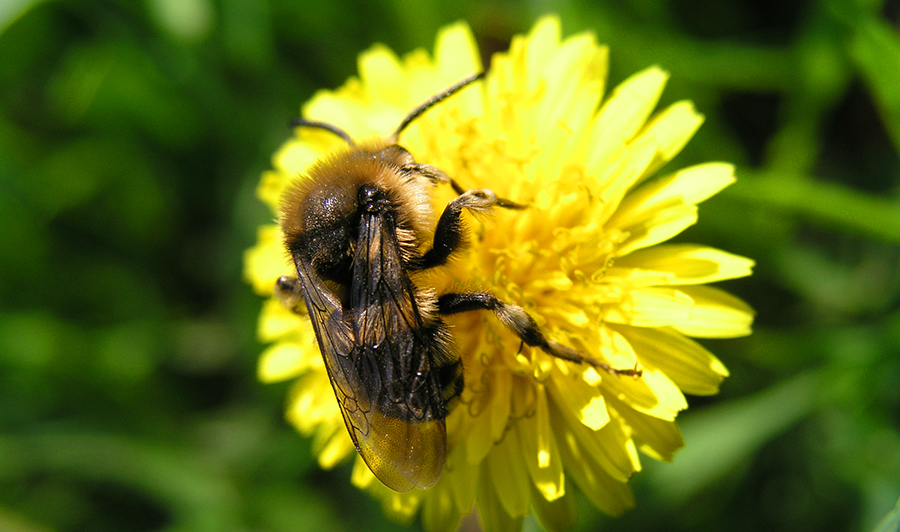“No Mow May” is a good start to rethinking bee health across our lawns
Lauren Phillips
Local Journalism Initiative Reporter
To mow or not to mow. That is the question. If you’re interested in helping spring pollinators adjust from winter hibernation into their busy flower season, you might have heard of the No Mow May campaign.
It asks people to let the grass blades grow long and wild for a month, to help bees and other insects during this transitional period. The Coast spoke with Dalhousie biology professor Paul Manning about how to help encourage biodiversity in human-dominated landscapes, like cities and suburbs.
Manning says No Mow May is a good step in helping people think about protecting local bees, which don’t often fit the stereotypical image of the fluffy, striped western or European honey bee–not a native species.
“Too often, when we are thinking about this idea of conserving bees, most people are thinking of one bee, the honey bee, that’s a species of managed livestock,” says Manning. “‘No Mow May’ definitely played a part in helping people realize there’s more to pollinators than just that,” but in terms of how to help wild pollinators native to here, Manning says No Mow May doesn’t have a lot of evidence showing it’s an effective intervention. “That’s because the plants that live in your lawn that you’re not mowing don’t tend to be those of super high value for our pollinators.”
The plants that are popping up right now on lawns are likely other non-native plants like dandelions, violets and ground ivy, says Manning. There’s some nutritional value to pollinators in those, however Manning says leading pollinator biologists are really advocating, instead, for choosing to plant native plants, shrubs and trees in your yard in place of, or between, a patch of grass.
So, if No Mow May isn’t quite it, what are some quick tips to create an appetizing and helpful space for hard-working spring pollinators? Manning has three that are accessible to people living in a variety of house types.
- Learn about native bees. “So often you hear about people killing ants that are living in the vicinity of them and then find out they’re actually bees,” says Manning, saying Nova Scotia, for example, is home to roughly 300 different bee species. “Native bees are not necessarily striped, they’re not necessarily big. They can be very small black things that look just like flying ants.” What’s more, they have a variety of habitat needs: some only feed on a few specific flowers. Some nest in the ground, some above. Some like dead sticks and some like to nest in old mouse burrows! Re-users!
- If you have any control over a piece of land, either a lawn or access to a public outdoor space, think about planting a native shrub or a tree, like a variety of maple tree. “They’re excellent sources for bees,” says Manning, “and additional benefits are all of those nice green leaves for caterpillars and other insects to feed on, which then feed birds, reduce air pollution in an urban environment, and you have the benefits of shade, which can help cool the surrounding neighbourhood if you have critical mass in trees and canopy cover.”
- If you use pesticides where you live, be cautious and informed. Make sure you know what you’re using and what insects they kill–sometimes there are helpful pictures of bugs on the bottles. “It’s very common people will use insecticides in their garden to kill many insects they see,” says Manning, “but use those very cautiously. I wouldn’t necessarily avoid them at all cost because they certainly have a purpose—if you’re getting stung by a wasp or taking a walk outside of your home, you may need to remove that nest with an insecticide—but be careful and realize they’re generally not very discerning” when it comes to what they kill.
There are many great resources available for those wanting to know more about native species of plants and insects, and many of them are free and online, says Manning. He points to the international conservation not-for-profit, XERCES, that has an expandable “Plant Lists” section on their website about relative benefits and roles of native plant species within certain geographic areas across North America.
Manning teaches the study of insects–entomology–conservation biology and a field course measuring food sustainability, from Dalhousie’s Agricultural Campus in Truro. He and others are in the process of a research project into the potential use of green space on that campus, which there’s quite a lot of.
“Some of these lawns have been mowed frequently for the sake of regular maintenance,” says Manning, despite them not serving any recreational function. “It’s just like an aesthetic function, so, over time, some of the grounds crew have stopped taking care of some of them in the same way but have left little borders around the edges.”
This is based on a concept introduced in an influential 1995 landscape architecture essay, called “Messy ecosystems, orderly frames.”
“The idea is: if you have ‘cues to care’, or signs that a land manager or landowner uses to show that this ‘messy ecosystem’ is actually not derelict, it’s purposefully managed,” says Manning, it can flip our understanding of what makes a cared-for versus abandoned landscape. This can include, “a sign saying ‘This is pollinator habitat,’ or a mowed border on the edge showing a really clean line between a corridor of green and something more wild,” he adds. Manning and others are using this concept to render images of Truro’s campus and suggest other strategies of making people comfortable “with the idea of ‘messy lawn care’ in the context of a university campus.”
In terms of other recommendations for those curious about the intersection of landscapes, humans and pollinators, Manning has a book and a researcher to share.
Manning recommends this book to people thinking about the best perennials to plant in their gardens perhaps in place of grass. Another great thing about the book, says Manning, is it lists “which moths and butterflies also use the leaves of these native plants as hosts for when they’re turning from caterpillars to butterflies or moths.”
The researcher Manning shouts out is Sheila Colla, a professor at York University in Ontario, who works mostly on bumblebees, however Manning says her work is clear, accessible and interesting for those wanting to know how to advocate for environmental social justice from the local bee and beyond.
Lauren Phillips
Local Journalism Initiative Reporter
The Coast




